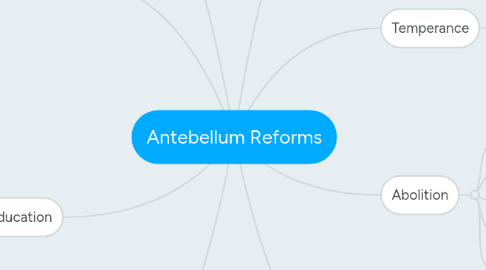
1. Suffrage-Origins
1.1. Who
1.1.1. Paulina Wright Davis
1.2. What
1.2.1. women's rights movement
1.3. When
1.3.1. 1813-1876
1.4. When
1.4.1. Indiana, Massachusetts, New York, Ohio, and Pennsylvania
1.5. Why
1.5.1. It lead to women getting the right to vote in 1920.
2. Education
2.1. Who
2.1.1. Americans
2.2. What
2.2.1. Education reform
2.3. When
2.3.1. 1820s
2.4. Where
2.4.1. Americans
2.5. Why
2.5.1. A desire to reform and expand education accompanied and informed many of the political, social, and economic impulses toward reform. Three particularly important core components of education reform developed in the Antebellum period: education for the common man and woman, greater access to higher education for women, and schooling for free blacks.
3. Lowell System
3.1. Who
3.1.1. Francis Cabot Lowell
3.2. What
3.2.1. It was a labor production model
3.3. When
3.3.1. 1790s
3.4. Where
3.4.1. Rhode Island
3.5. Why
3.5.1. Made possible by inventions such as the spinning jenny, spinning mule, and water frame around the time of the American Revolution, the textile industry was among the earliest mechanized industries, and models of production and labor sources were first explored here.
4. Utopias
4.1. Who
4.1.1. American communities
4.2. What
4.2.1. utopias
4.3. When
4.3.1. 19th century
4.4. Where
4.4.1. America
4.5. Why
4.5.1. Trying to achieve a culture that was distinct and not imitative of any in Europe.
5. Temperance
5.1. Who
5.1.1. Americans
5.2. What
5.2.1. reduce the consumption of alcohol
5.3. When
5.3.1. throughout the 19th century
5.4. Where
5.4.1. America
5.5. Why
5.5.1. Families were being damaged from too much drinking and alcohol was a source of violence and crime.
6. Abolition
6.1. Who
6.1.1. Slaves
6.2. What
6.2.1. Getting rid of slavery
6.3. When
6.3.1. 1812-1860
6.4. Where
6.4.1. America
6.5. Why
6.5.1. wasn't right because all people are created equal.
7. Mental Health-Dorothea Dix
7.1. Who
7.1.1. Dorothea Dix
7.2. What
7.2.1. Mental health
7.3. When
7.3.1. 1802-1887
7.4. Where
7.4.1. US and Europe
7.5. Why
7.5.1. Was an author, teacher, and reformer. Her efforts on behalf on behalf of the mentally ill and prisoners helped dozens of new institutions across the United States and in Europe and changed people's perceptions of these populations.
8. Second Great Awakening
8.1. Who
8.1.1. Americans (Catholics and Christians)
8.2. What
8.2.1. Revival of religion, making of new religious denominations
8.3. When
8.3.1. 1800-1860
8.4. Where
8.4.1. America
8.5. Why
8.5.1. Population growth

